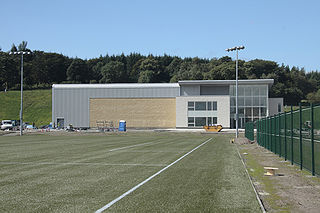Related Research Articles

Lennoxtown is a town in East Dunbartonshire council area and the historic county of Stirlingshire, Scotland at the foot of the Campsie Fells, which are just to the north. The town had a population of 4,094 at the 2011 UK Census.
Mauchline railway station was a railway station serving the town of Mauchline, East Ayrshire, Scotland. The station was originally part of the Glasgow, Paisley, Kilmarnock and Ayr Railway.
Lugar railway station was a railway station serving the Lugar Ironworks, East Ayrshire, Scotland. The station was originally part of the Glasgow, Paisley, Kilmarnock and Ayr Railway.

The Caledonian Railway main line in Scotland connected Glasgow and Edinburgh with Carlisle, via Carstairs and Beattock.
The Glasgow to Aberfoyle Line was a railway line in Scotland, built in stages, leaving the Edinburgh and Glasgow Railway near Lenzie. Tourist traffic was a dominant part of the motivation for building the line, and road tours to the Trossachs from Aberfoyle formed a significant part of the traffic.

Lennoxtown Training Centre is Celtic F.C.'s training centre, located at Lennoxtown, East Dunbartonshire in Scotland. The complex houses the club's training and educational facilities.
The Edinburgh and Northern Railway was a railway company authorised in 1845 to connect Edinburgh to both Perth and Dundee. It relied on ferry crossings of the Firth of Forth and the Firth of Tay, but despite those disadvantages it proved extremely successful. It took over a short railway on the southern shore of the Forth giving a direct connection to Edinburgh, and it changed its name to the Edinburgh, Perth and Dundee Railway.

Ketton and Collyweston railway station is a former station serving the villages of Ketton, Geeston, Aldgate and Collyweston, Rutland. It is located in Geeston adjacent to a level crossing on the Ketton to Collyweston road. It is under half a mile from Ketton but over a mile from Collyweston. It closed in 1966.

Five Mile House was a railway station on the Lincolnshire Loop Line which served the village of Fiskerton in Lincolnshire between 1848 and 1964. Situated on the south bank of the River Witham, passengers on the north bank had to use a ferry to reach it. It closed two years after opening due to low traffic, but reopened fifteen years later. Passenger services were withdrawn in 1958, leaving the station open for anglers' excursions until 1964. The Water Rail Way footpath now runs through the site.

Racks railway station was a railway station in Dumfries and Galloway, Scotland, south of Dumfries, OS NGR NY 033 743, serving and effectively creating the village of Racks near the Lochar Water, 4 miles ESE of Dumfries; a rural community within the Parish of Torthorwald.
Southside railway station, Glasgow, Scotland, was an early passenger terminal situated in the Gorbals area of the city. The station opened on 29 September 1848, for trains operated by the Glasgow, Barrhead and Neilston Direct Railway, which a short time later was absorbed by the Caledonian Railway.

Ruthwell railway station was a railway station in Dumfries and Galloway south of Dumfries, serving the village of Ruthwell with its famous 8th century carved cross; a rural community within the Parish of Ruthwell, lying a half-mile (1 km) north of Clarencefield and 1+1⁄4 miles (2.0 km) south southwest of Carrutherstown.

Peebles Hydro is an early 20th century hotel and spa resort in Peebles, in the historic county of Peebles-shire in the Scottish Borders. It is one of two hydropathic hotels left in Scotland, the other being Crieff Hydro in Perthshire.

Kilsby and Crick was a railway station on the Northampton Loop Line serving the villages of Kilsby and Crick in Northamptonshire. It was located to the eastern side of where the railway crossed the A5 road at the site now occupied by the Daventry International Rail Freight Terminal. It was located about a mile from Kilsby and one and a half from Crick.

Greenhill Lower railway station served the village of Greenhill, Falkirk, Scotland from 1848 to 1966 on the Scottish Central Railway.
Lennoxtown railway station served the town of Lennoxtown, Dunbartonshire, Scotland from 1867 to 1951 on the Blane Valley Railway.
Jock's Lodge railway station served the area of Jock's Lodge, Edinburgh, Scotland from 1847 to 1848 on the Waverley Route and the East Coast Main Line.
Overtown railway station, also known as Overtown Road railway station, served the village of Overtown, North Lanarkshire, Scotland from 1843 to 1942 on the Wishaw and Coltness Railway.
Cleghorn railway station served the village of Cleghorn, South Lanarkshire, Scotland from 1848 to 1965 on the Caledonian main line.
Kinning Park was a 19th-century sports ground in Kinning Park, Renfrewshire, Scotland, primarily used for cricket and football. It was the home of Clydesdale Cricket Club from 1849, staging a number of important matches against visiting English teams. It was also the original home of the club's football team, Clydesdale F.C. When both teams relocated to Titwood in 1876, Kinning Park was taken over by Rangers F.C., who played there until moving to the first Ibrox Park in 1887. The ground was the venue for the 1881 Scottish Cup Final between Queen's Park and Dumbarton.
References
Coordinates: 55°58′25″N4°12′07″W / 55.9737°N 4.2019°W